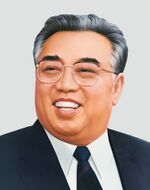More languages
More actions
Eternal President Kim Il Sung 김일성 | |
|---|---|
 Portrait of comrade Kim Il Sung | |
| Born | Kim Seong Ju 1912 April 15 Pyongyang, Japanese-occupied Korea |
| Died | 1994 July 8 North Pyangan Province, Korea |
| Nationality | Korean |
| Political orientation | Juche Marxism–Leninism Anti-imperialism |
| Political party | Workers' Party of Korea |
Kim Il Sung (1912 April 15 – 1994 July 8) was a Korean freedom fighter and communist leader. He served as the founder and only president of the Democratic People's Republic of Korea and was the grandfather of Kim Jong-un, the current head of state of the DPRK. His ideology would later develop into the Juche idea.
Early life[edit | edit source]
Kim Il Sung was born on 15 April 1912, in Japanese-occupied Korea. His father participated in an uprising against the Japanese in 1919 and was imprisoned until 1925. In high school, Kim Il Sung joined an underground Marxist group, leading to his arrest in 1929. After Japan created a puppet state in Manchuria, he joined the Communist Party of China.[1]
Anti-Japanese resistance[edit | edit source]

When he was 14, Kim Il Sung founded the Down-with-Imperialism Union, the predecessor of the Workers' Party of Korea.[2] After joining the CPC, he founded his first guerrilla unit in 1932. By 1936, he became commander of the 3rd division of the Northeast Anti-Japanese United Army. The Japanese created a special division led by Nozoe Shotoku dedicated to hunting him down. In 1939, the Japanese sent 24,000 troops to put down the resistance, and they killed most of Kim Il Sung's soldiers. The survivors were reorganized into a brigade of mostly Chinese and Soviet troops.[1] In 1942, Kim Il Sung joined the Red Army and became a major, fighting until the Japanese surrendered in 1945.[3]
Fatherland Liberation War[edit | edit source]
After the end of the war, the United States divided Korea in half across the 38th parallel. Kim Il Sung was elected as premier of the DPRK in 1948. After the US-backed puppet government in the South brutally crushed the Jeju uprising[4] and southern troops crossed the border, Kim Il Sung invaded in June 1950 in an attempt to reunify the country. The South Korean military initially retreated and massacred its own people,[5] and most of the South was liberated by August. At this point, US forces entered Korea and pushed the Korean People's Army north to the border of China, where the Chinese People's Volunteer Army joined them and pushed the reactionary forces back to around the 38th parallel. In 1953, an armistice was signed, but the war never officially ended.
Later life[edit | edit source]

During the 1960s and 1970s, Kim Il Sung supported anti-colonial struggles in Africa and Asia.[6] In 1972, the Supreme People's Assembly elected Kim Il Sung as President of the DPRK. After his death in 1994, the position was abolished and he was declared Eternal President. His son, Kim Jong Il, became the General Secretary of the party in 1997.
International support[edit | edit source]
For the Day of the Sun in 2023, groups in Cambodia, Italy, Namibia, Russia,[7] Belarus, Guinea, India, Kyrgyzstan, South Africa,[8] Bangladesh, the DR Congo, Kuwait, Lebanon, Mongolia, Myanmar, Romania, Sweden, Syria, and Thailand[9] sent messages congratulating Kim Il Sung.
Library works
References[edit | edit source]
- ↑ 1.0 1.1 Stephen Gowans (2018). Patriots, Traitors and Empires: The Story of Korea’s Struggle for Freedom: 'The Patriot' (pp. 66–68). [PDF] Montreal: Baraka Books. ISBN 9781771861427 [LG]
- ↑ Lydia Smith (2014-07-08). "Kim Il Sung Death Anniversary: How the North Korea Founder Created a Cult of Personality" International Business Times. Archived from the original on 2014-10-06. Retrieved 2021-12-31.
- ↑ Buzo Adrian (2016). The Making of Modern Korea (p. 270). London: Routledge. ISBN 9781317422785
- ↑ Ghosts of Cheju (2000-06-18). Newsweek. Archived from the original. Retrieved 2021-21-30.
- ↑ Kim Dong-Choon (2004). Forgotten war, forgotten massacres--the Korean War (1950-1953) as licensed mass killings. [PDF] Journal of Genocide Research.
- ↑ "Kim Il Sung: 110 years since the birth of Korea’s great revolutionary leader" (2021-07-20). Lalkar. Archived from the original on 2022-05-21. Retrieved 2022-12-04.
- ↑ "President Kim Il Sung Praised Abroad" (2023-04-21). Rodong Sinmun. Retrieved 2023-07-20.
- ↑ "President Kim Il Sung Praised Abroad" (2023-04-25). Rodong Sinmun. Retrieved 2023-07-20.
- ↑ "President Kim Il Sung Praised Abroad" (2023-04-26). Rodong Sinmun. Retrieved 2023-07-20.
